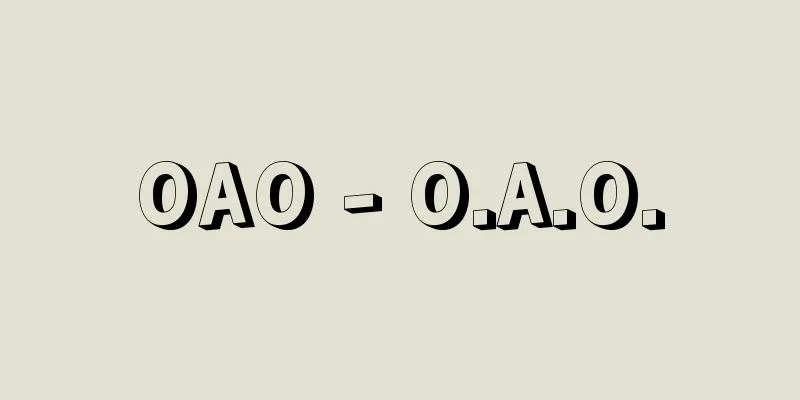Judaism

|
Judaism is the religion of the Jews. Currently, synagogues and Jews are scattered all over the world, but even though their nationalities, everyday languages, and skin colors may differ, all of the people who gather for synagogue worship are Jewish. Although there are exceptions, there are also cases of people who convert, and it is customary for rabbis (Jewish teachers) who perform conversion ceremonies to urge candidates to change their minds three times, making Judaism a typical ethnic religion. [Koichiro Ishikawa] historyThe history of Judaism is as old as the history of the people. Archaeology estimates that it was around the 18th century BC that the semi-nomadic ancestors of the Semitic people of the Jews began to settle along the eastern coast of the Mediterranean Sea from Mesopotamia in a major wave of ethnic migration. The account of Abraham in Genesis Chapter 12 and following in the Old Testament reflects this situation. A landmark event in the history of Judaism was the exodus of the people from Egypt under the leadership of Moses and the signing of a covenant with God Yahweh on Mount Sinai. This event, estimated to have taken place in the first half of the 13th century BC, was not something that happened to the entire people as legend (the Book of Exodus) tells us, but rather to a part of the people, centered around the Josephites, who had fled from the land of Canaan to Egypt to escape the dangers of famine and other hardships. However, this event took deep root in the consciousness of the people as God's work of salvation for the entire people. God Yahweh and the people interacted as a legal act based on each person's subjective choice, and at that time, the "teachings" (the Torah), which encompassed doctrine, customs, and ethics, were revealed to them in order to become a "holy people," which is the basis of the covenant. Here, the monotheism and ethical character of Judaism are already clearly established. The history of the Jewish people since the construction of the Temple in Jerusalem in the 10th century BCE has been a continuous tragic journey of national extinction, dispersion, persecution, and massacres, and has always been a struggle for a national identity. The loss of the Temple in Jerusalem, destroyed by the Romans in 70 AD, was particularly decisive for Judaism, because it forced a fundamental transformation of its previous way of being, which had been centered on the Temple rituals. The reason why the Jewish people were able to cope well with such a situation was the result of the efforts of normative Judaism, which descended from the Pharisees, who aimed for strict observance of the law. They placed emphasis on prayer in the synagogue and daily study of the law instead of the Temple rituals, and sought a standard for Jewish behavior in the Law as the Word of God. It can be said that their position of recognizing oral tradition in addition to the written Law gave them the flexibility to deal with critical situations. This oral law was later compiled into the Talmud, which became the code of conduct and life for Jews, and determined the character of Judaism that continues to this day. The more Judaism emphasized its normative religion after the Talmud, the more mystical tendencies that emphasized the religious feelings of humans that could not be satisfied by this normativity developed. This was a philosophy that sought to grasp the truth hidden behind the words of the Law and the Talmud through spiritual effort, and was popular in medieval Spain and Palestine. This Jewish mystical philosophy, called Kabbalah, is represented by works such as the Zohar (The Book of Splendor). From this trend, Hasidism, which hopes to achieve mystical communion with God by concentrating the mind on prayer, arose in Poland in modern times and captured the hearts of Eastern European Jews. Throughout the Middle Ages, Jews continued to live isolated lives in religious, cultural, and social terms within their scattered societies. However, the Enlightenment ideas of modern Western Europe reached them without exception, and unfolded as the liberation of humanity. In their case, however, the liberation of humanity also meant the elimination of ethnic identity. The Reformation movement that emerged in Germany from this movement promoted the modernization of synagogue worship, but also clearly showed a tendency to exclude ethnic identity, such as by deleting from the prayer book the passages about the rebuilding of Zion and the revival of the Jerusalem Temple rituals. They placed particular emphasis on the highly universal ethical ideas of the prophets. It was in the United States, where there was no constraint from tradition, that the Reformation movement was able to operate most freely. Conservative Judaism arose among people who were concerned about the tension between tradition and modernity, but could not keep up with the overly radical Reform movement. They sought to accept historically based reforms and increase adaptability to modern society while respectfully maintaining the essence of traditional Judaism. To this end, it was necessary to historically examine the path Judaism had taken, which led to the development of what is known as "Jewish studies." All European Jews who did not conform to the Reform and Conservative movements of the 19th century are called Orthodox. A very small portion of the Orthodox reject all change and try to maintain medieval traditional Judaism. They do not accept modern culture, including television and newspapers. However, the majority of the rest are so-called neo-Orthodox, who accept the cultural values of modern society. This is not a concession to the flow of the times, but because they understand that absorbing the culture of the surrounding society and expressing Jewish values and ideas in the language of that society is an inherent necessity of Judaism, as is clear from past history. Of course, they do not accept historical critical research methods, but they are still flexible in the interpretation and application of standards of Halacha, which is the regulation of daily behavior. Thus, in modern times, the three factions of Orthodoxy, Conservatives, and Reform coexist. [Koichiro Ishikawa] ScriptureThe holy book of Judaism is the Hebrew Bible (its contents are the same as the Old Testament of Protestant Christianity). In particular, the first five books, Genesis, Exodus, Leviticus, Numbers, and Deuteronomy, are called the Torah and considered sacred. This is because they are believed to be God's direct revelation of His will to Moses. However, according to later Jewish tradition, the revelation Moses received on Mount Sinai was thought to include not only the written Torah but also the oral law (see Mishnah Avot 1.1 et seq.). Therefore, both the written law (the five books of Moses) and the oral law (the Mishnah) have been considered to have divine authority. The Mishnah was compiled by Rabbi Judah around 200, and legal scholars in both Palestine and Mesopotamia subsequently used it as a basic text to develop various discussions and add annotations. The Talmud is a compilation of these discussions and commentaries, along with the Mishnah text. The version completed in Palestine in the second half of the 4th century is called the Jerusalem (Palestinian) Talmud, while the Babylonian Talmud was a separate compilation of the work of scholars in Mesopotamia around 500. The Jews who lost their homeland and were scattered all over the world were able to maintain their identity as Jews by following the religious code of conduct set out in the Talmud. This is why it is called a "portable homeland" (C. Ross). Therefore, it can be said that the Talmud has a position equivalent to the Holy Scriptures in Judaism. [Koichiro Ishikawa] Sabbaths and FestivalsThe most important "time" in the week is the Sabbath. It is the day from Friday sunset to Saturday evening. On this day, Jews are forbidden to engage in any daily work. It is said that Jews must withdraw from interacting with the natural world and the human world in order to recognize that God alone is the creator and Lord of all that exists. In ancient Israel, there were three major pilgrimage festivals to the Temple in Jerusalem: the Feast of Tabernacles (Sukkot), Passover (Pesach), and Pentecost (Shavuot). All were agricultural festivals related to the harvest, but they are linked to historical events and have continued to be celebrated even after the loss of the Temple. The Feast of Tabernacles commemorates life in the wilderness after the Exodus from Egypt, Passover commemorates the miraculous events during the Exodus, and Pentecost commemorates the revelation of the Torah on Mount Sinai. In the Jewish calendar, the year begins in the autumn month of Tishri. At the beginning of the month, they celebrate Rosh Hashanah (New Year's Day), and on the tenth day of the month they celebrate Yom Kippur (Day of Atonement). This day is the most solemn time in Judaism, when people fast completely throughout the day to seek repentance and God's forgiveness, and spend the whole day praying in the synagogue. They confess their sins, regret the shortcomings of humankind, praise God's infinite mercy, and pray for the liberation of the Jewish people from the bondage of religious vows to the solemn melody of the heart-warming song Kol Nidrei. In addition, there is the eight-day festival of Hanukkah in December. It celebrates the rededication of the desecrated temple after overthrowing the Seleucid dynasty (Syria) in the mid-2nd century BCE. It is also said to commemorate the miracle of a single jar of pure oil burning as a lamp for eight days during the rededication of the temple. It is customary to light an eight-branched candlestick in a window. Also, on the 14th day of the spring month of Adar, the festival of Purim is celebrated, commemorating the salvation of the Jews as told in the Book of Esther. [Koichiro Ishikawa] "The Jews: Their Faith and Life, by A. Untermann, translated by Ishikawa Koichiro and Ichikawa Yutaka (1983, Chikuma Shobo)" ▽ "The Jewish People and Religion, by A. Siegfried, translated by Suzuki Ichiro (Iwanami Shinsho)" ▽ "The Development and Genealogy of Jewish Thought, by I. Epstein, translated by Asaka Eiji and Koizumi Akira (1975, Kinokuniya Shoten)" ▽ "History of Judaism, by Ishida Tomoo (1980, Yamakawa Publishing)" ▽ "Jewish Thought, by A. Schraki, translated by Watanabe Yoshiaki (Hakusuisha, Que sais-je Bunko)" ▽ "History of the Jewish People, edited by H.H. Ben-Sasson, translated by Ishida Tomoo et al., six volumes (1976-78, Rokuko Publishing)" ▽ "The History of the Jews, by Cecil Roth, translated by Hasegawa Makoto and Asaka Eiji (1966, Misuzu Shobo)" [References] | | | | | | |©Shogakukan "> Jewish Sabbaths and Festivals Source: Shogakukan Encyclopedia Nipponica About Encyclopedia Nipponica Information | Legend |
|
ユダヤ教はユダヤ人の宗教である。現在全世界にシナゴーグ(会堂)とユダヤ教徒が散在するが、国籍や日常言語、皮膚の色は異なっても、シナゴーグの礼拝に集まる人々はいずれもユダヤ人である。例外的に改宗者がいないわけではないが、改宗の儀式をつかさどるラビ(ユダヤ教教師)は3回にわたって志願者の翻意を促す慣行があるほどで、典型的な民族宗教の一つである。 [石川耕一郎] 歴史ユダヤ教の歴史は民族の歴史とともに古い。セム人に属する半遊牧的なユダヤ人の祖先が、民族移動の大きな波のなかでメソポタミアから地中海東岸沿いの地に定住するようになったのは、紀元前18世紀ごろのことと考古学では推定する。『旧約聖書』の「創世記」12章以下のアブラハムの記事はこのような状況を反映している。 ユダヤ教にとって歴史上画期的なできごとは、モーセの指導により民族がエジプトから脱出し、シナイ山において神ヤーウェと契約を結んだことであった。前13世紀前半と推定されるこの事件は伝承(出エジプト記)が語るような民族全体のものではなく、カナーンの地から飢饉(ききん)などで難をエジプトに避けていたヨセフ人を中心とする民族の一部であったろう。しかし、これは民族全体にかかわる神の救いの業(わざ)としてこの民族の意識のなかに深く根を下ろした。神ヤーウェと民とはおのおの主体的な選択に基づく法的行為としてかかわりをもち、その際契約の根底である「聖なる民」となるために教義、慣習、倫理を包括した「教え」(律法(トーラー))が啓示された。ここにユダヤ教の一神性と倫理的性格がすでに明確に打ち出されている。 前10世紀にエルサレム神殿を建立してからの民族の歴史は、亡国、離散、迫害、虐殺という悲劇的な歩みの連続であり、つねに民族のアイデンティティを求める闘いであった。紀元後70年にローマの手で破壊されたエルサレム神殿の喪失は、ユダヤ教にとってとりわけ決定的な意味をもった。なぜなら、神殿祭儀を中心としていたそれまでのあり方が根本的に変質を迫られることになったからである。このような状況によく対処しえたのは、律法の厳格な遵守を目ざすパリサイ派の流れをくむ規範的ユダヤ教の努力の結果であった。彼らは、神殿祭儀にかえてシナゴーグでの祈りや日常的な律法研究を重視し、神のことばとしての律法のなかにユダヤ人としての行動の規範を追求した。成文律法のほかに口伝(くでん)の伝承をも認める立場が、危機的状況に対処しうる弾力性を与えたといえよう。この口伝律法はその後タルムードに集大成されてユダヤ教徒の生活と行動の規範となったものであり、現在にまで続くユダヤ教の性格を決定することとなった。 ユダヤ教がタルムード以後規範的宗教としての特質を強調すればするほど、この規範性によっては満たしえない人間の宗教的心情を重視する神秘主義的傾向も大きな流れとなって展開する。これは、律法やタルムードの文字の背後に隠されている真理を霊的努力によって把握しようとする思想であり、中世スペインやパレスチナで盛んとなった。カバラとよばれるこのユダヤ教神秘主義思想は『ゾハール』(光輝の書)などに代表されている。この流れのなかから、近代に入って、祈りに精神を集中することによって神との神秘的交わりを得ることを願うハシディズムがポーランドにおこり、東欧ユダヤ人の心をとらえていった。 ユダヤ人は中世を通じて宗教的にも文化的にも、また社会的にも離散社会のなかで孤立した生活を続けてきた。しかし近代西ヨーロッパの啓蒙(けいもう)思潮は彼らのうえにも例外なく及び、人間性の解放として展開する。しかし彼らの場合、人間性の解放は同時に民族性の排除でもあった。この動きのなかからドイツで誕生した改革派は、シナゴーグ礼拝の近代化を推し進めたが、祈祷(きとう)書からシオンの再建とエルサレム神殿祭儀の復活を削除するなど、民族性排除の傾向をはっきりとうかがわせる。彼らは普遍性の高い預言者の倫理思想をとくに強調した。この改革派がもっとも自由に活躍しえたのは、伝統の束縛がないアメリカ合衆国においてであった。 伝統と現代性との間の緊張を問題としつつも、あまりに過激に走る改革派の動きについてゆけぬ人々の間から保守派ユダヤ教が生まれた。彼らは伝統的ユダヤ教の本質をたいせつに維持しながら、歴史に根拠のある改革を受け入れ、現代社会への適応性を高めようとした。このためには、ユダヤ教の歩んできた道を歴史的に検証する必要があり、いわゆる「ユダヤ学」発展の契機となった。 19世紀の改革派、保守派の動きに同調しなかったヨーロッパのユダヤ人はすべて正統派とよばれる。正統派のうちでもごく一部の人々はいっさいの変革を拒否し、中世的伝統主義ユダヤ教を保守しようとする。彼らはテレビ、新聞をはじめ、現代文化を受け入れない。しかしその他の大部分は、いわゆる新正統派とよばれる人々で、現代社会の文化価値を受け入れる。これは、時代の流れへの譲歩ではなく、環境社会の文化を吸収し、かつその社会のことばでユダヤ教の価値と思想を表現するのは、過去の歴史に明らかなごとくユダヤ教本来の必然性である、と理解するからである。歴史批評的研究方法を彼らが受けつけないことはもちろんだが、日常行動の諸規定であるハラハーHalachaの解釈と基準の適用にはそれでも柔軟性が認められる。このように現代では正統派、保守派、改革派の三派が並存しているのが現状である。 [石川耕一郎] 聖典ユダヤ教の聖典はヘブライ語の聖書である(内容的にはプロテスタント・キリスト教の『旧約聖書』と共通)。とくに冒頭の「創世記」「出エジプト記」「レビ記」「民数記」「申命記(しんめいき)」のいわゆる「モーセ五書」はトーラー(律法)とよばれて神聖視されている。神がその意志をモーセに直接啓示した内容と信じられているからである。しかし後のユダヤ教の伝承によれば、シナイ山でモーセが受けた啓示の内容は、成文化されているトーラーだけではなく、口伝の律法をも含むと考えられた(ミシュナ・アボット1.1以下参照)。したがって成文律法(モーセ五書)と並んで口伝律法(ミシュナ)がともに神的権威をもつものと受けとめられてきた。このミシュナは200年ごろラビ・ユダによって結集され、その後パレスチナ、メソポタミア両地の律法学者がこれを基本テキストとして多様な議論を展開し、かつ注釈を加えていった。この議論および注釈をミシュナ本文とあわせて集大成したのがタルムードである。4世紀後半にパレスチナで完成したものはエルサレム(パレスチナ)・タルムードとよばれ、これとは別にメソポタミア地域の学者の成果を500年ごろ集成したのがバビロニア・タルムードとなった。 祖国を失い世界の各地に離散したユダヤ人がタルムードの示す宗教的行動規範に従うことによって、ユダヤ人としてのアイデンティティを保持することができたのである。「持ち運びのできる祖国」(C・ロス)と称されるゆえんである。したがってユダヤ教にとってタルムードは聖典に準じるものとしての位置づけをもっているといってよい。 [石川耕一郎] 安息日と祭り1週間の生活でもっとも重要な「時」は安息日である。金曜の日没から土曜の夕までの1日である。この日ユダヤ人はいっさいの日常の仕事に従事することを禁じられている。神のみが存在するいっさいの創造者であり、主であることを認識するために、自然界と人間が営む世界への働きかけからユダヤ人は身を退けなければならない、とされる。 古代イスラエルにはエルサレム神殿に詣(もう)でる三大巡礼祭があった。仮庵(かりいお)祭(スッコート)、過越(すぎこし)祭(ペサッハ)、五旬節(シャブオート)である。いずれも収穫に関連した農耕的な祭りであったが、歴史のできごとと結び付けられて神殿喪失後現在に至るまで祝われ続けている。仮庵祭はエジプト脱出後の荒野での生活、過越祭はエジプト脱出時の奇跡的故事、五旬節はシナイ山におけるトーラーの啓示を記念する行事である。 ユダヤ人の暦では秋のティシュリの月に1年が始まる。月初めに新年祭(ローシュ・ハッシャナ)を祝い、その月の10日に贖罪(しょくざい)の日(ヨーム・キップール)を迎える。この日はユダヤ教におけるもっとも厳粛なときであり、悔い改めと神の赦(ゆる)しを求めてこの日一日完全に断食(だんじき)を守り、シナゴーグで祈りに終始する。罪を告白し、人間の至らなさを悔いるとともに神の無限の慈(いつく)しみをたたえ、心にしみ渡るコル・ニドレイの壮重な調べにのせて宗教的な誓いの束縛からユダヤ人が解放されることを願う。 このほかに12月に8日間のハヌカー祭がある。前2世紀中ごろセレウコス家(シリア)の支配をはねのけて、穢(けが)された神殿を潔(きよ)めて再奉献したことを祝う。また一説には、わずか一壺(つぼ)の穢れていない油が神殿再奉献の際8日間も灯明(とうみょう)として燃え続けた奇跡を記念するともいわれる。八枝の燭台(しょくだい)を窓辺でともす慣習がある。また春のアダルの月14日には、「エステル記」に語られるユダヤ人の救いを記念したプリムの祭りが祝われる。 [石川耕一郎] 『A・ウンターマン著、石川耕一郎・市川裕訳『ユダヤ人――その信仰と生活』(1983・筑摩書房)』▽『A・シーグフリード著、鈴木一郎訳『ユダヤの民と宗教』(岩波新書)』▽『I・エプスタイン著、安積鋭二・小泉仰訳『ユダヤ思想の発展と系譜』(1975・紀伊國屋書店)』▽『石田友雄著『ユダヤ教史』(1980・山川出版社)』▽『A・シュラキ著、渡辺義愛訳『ユダヤ思想』(白水社・文庫クセジュ)』▽『H・H・ベンサソン編、石田友雄他訳『ユダヤ民族史』全六巻(1976~78・六興出版)』▽『シーセル・ロス著、長谷川真・安積鋭二訳『ユダヤ人の歴史』(1966・みすず書房)』 [参照項目] | | | | | | |©Shogakukan"> ユダヤ教の安息日と祭り 出典 小学館 日本大百科全書(ニッポニカ)日本大百科全書(ニッポニカ)について 情報 | 凡例 |
<<: Jews - Yudayajin (English spelling)
>>: Jewish Music - Yudayaonogaku
Recommend
Haga [town] - Haga
A town in Haga County in the southeastern part of ...
Otsu Incident
The Assault on the Russian Crown Prince. It is al...
External photoelectric effect
When light is shone on the surface of an object (u...
Column method - Karamuho
...It is also used in analytical equipment such a...
Bourdieu, P. (English spelling) BourdieuP
… Furthermore, today culture is an issue in the t...
Kuguno [town] - Kuguno
A former town in Ono County in the central north o...
Tide pool - Tide pool
Also called a tide pool, it is a depression in the...
Prodikos
…The representative sophists of the time were Pro...
Mentha pulegium (English spelling) Menthapulegium
…[Nitta Aya]. . . *Some of the terminology that m...
Bhavnagar (English spelling)
An industrial city on the east coast of the Katiaw...
Analytical Geometry
It is a method of solving classical geometry prob...
Dominion of Canada - Canada Jichiryo (English spelling)
The official name of Canada from 1867 to 1951. Bas...
Kinsha (golden gauze) - car
A gauze with a pattern sewn or embroidered on it. ...
Contumax nodulosus (English spelling) Contumax nodulosus
...Because they are abundant, they are used as ma...
Seed rice - Tanemomi
〘 noun 〙 The rice grains selected and set aside to...









